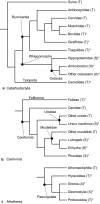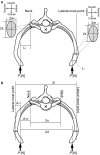Farewell to life on land - thoracic strength as a new indicator to determine paleoecology in secondary aquatic mammals
- PMID: 27396988
- PMCID: PMC5108153
- DOI: 10.1111/joa.12518
Farewell to life on land - thoracic strength as a new indicator to determine paleoecology in secondary aquatic mammals
Abstract
Habitat shifts from land to water have occurred independently in several mammal lineages. However, because we do not know completely about the relationship between skeletal morphology and function, both reliable life reconstructions of each extinct taxon and the timing of those shifts in locomotor strategies are yet to be fully understood. We estimated the strengths of rib cages against vertical compression in 26 extant and four extinct mammal specimens including cetartiodactyls, paenungulates, and carnivorans, representing 11 terrestrial, six semi-aquatic, and nine obligate aquatic taxa. Our analyses of extant taxa showed that strengths were high among terrestrial/semi-aquatic mammals, whose rib cages are subjected to vertical compression during the support on land, whereas strengths were low among obligate aquatic mammals, whose rib cages are not subjected to antigravity force in the water. We therefore propose rib strength as a new index to estimate the ability of an animal to be supported on land while being supported by either the forelimbs or thoracic region. According to our analyses of extinct taxa, this ability to be supported on land was rejected for a basal cetacean (Cetartiodactyla: Ambulocetus) and two desmostylians (Paenungulata: Paleoparadoxia and Neoparadoxia). However, this ability was not rejected for one desmostylian species (Desmostylus). Further study of the ribs of extant/extinct semi-aquatic taxa may help in understanding the ecological shifts in these groups.
Keywords: aquatic; desmostylian; early cetacean; reconstruction; rib.
© 2016 Anatomical Society.
Figures




Similar articles
-
Bone inner structure suggests increasing aquatic adaptations in Desmostylia (Mammalia, Afrotheria).PLoS One. 2013;8(4):e59146. doi: 10.1371/journal.pone.0059146. Epub 2013 Apr 2. PLoS One. 2013. PMID: 23565143 Free PMC article.
-
Sink or swim? Bone density as a mechanism for buoyancy control in early cetaceans.Anat Rec (Hoboken). 2007 Jun;290(6):638-53. doi: 10.1002/ar.20533. Anat Rec (Hoboken). 2007. PMID: 17516430
-
Energetic tradeoffs control the size distribution of aquatic mammals.Proc Natl Acad Sci U S A. 2018 Apr 17;115(16):4194-4199. doi: 10.1073/pnas.1712629115. Epub 2018 Mar 26. Proc Natl Acad Sci U S A. 2018. PMID: 29581289 Free PMC article.
-
Cetacean brains: how aquatic are they?Anat Rec (Hoboken). 2007 Jun;290(6):694-700. doi: 10.1002/ar.20530. Anat Rec (Hoboken). 2007. PMID: 17516433 Review.
-
Evolving between land and water: key questions on the emergence and history of the Hippopotamidae (Hippopotamoidea, Cetancodonta, Cetartiodactyla).Biol Rev Camb Philos Soc. 2011 Aug;86(3):601-25. doi: 10.1111/j.1469-185X.2010.00162.x. Epub 2010 Oct 15. Biol Rev Camb Philos Soc. 2011. PMID: 20946539 Review.
Cited by
-
Fitting unanchored puzzle pieces in the skeleton: appropriate 3D scapular positions for the quadrupedal support in tetrapods.J Anat. 2018 May;232(5):857-869. doi: 10.1111/joa.12778. Epub 2018 Jan 11. J Anat. 2018. PMID: 29322521 Free PMC article.
-
The range of atlanto-occipital joint motion in cetaceans reflects their feeding behavior.J Anat. 2020 Mar;236(3):434-447. doi: 10.1111/joa.13111. Epub 2019 Nov 8. J Anat. 2020. PMID: 31702831 Free PMC article.
References
-
- Ahlberg PE (1995) Elginerpeton pancheni and the earliest tetrapod clade. Nature 373, 420–425.
-
- Alexander R (1985) The Structure of Biological Science. Cambridge: Cambridge University Press.
-
- Bayraktar HH, Morgan EF, Niebur GL, et al. (2004) Comparison of the elastic and yield properties of human femoral trabecular and cortical bone tissue. J Biomech 37, 27–35. - PubMed
-
- Beatty BL (2009) New material of Cornwallius sookensis (Mammalia: Desmostylia) from the Yaquina Formation of Oregon. J Vert Paleontol 29, 894–909.
-
- Biewener AA (1990) Biomechanics of mammalian terrestrial locomotion. Science 250, 1097–1103. - PubMed
Publication types
MeSH terms
LinkOut - more resources
Full Text Sources
Other Literature Sources
Medical

